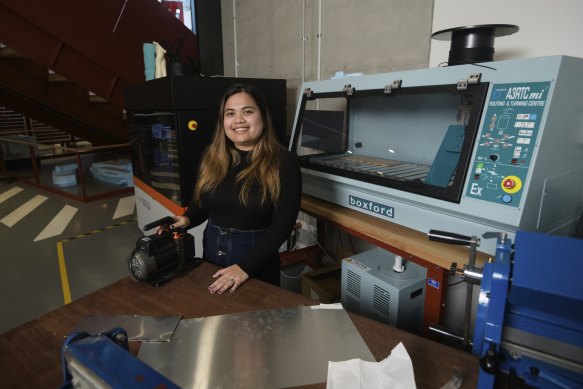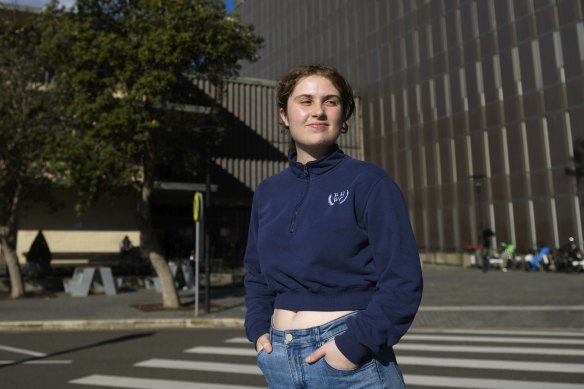This was published 7 months ago
Degrees that lead graduates to the biggest pay packets revealed
Students paying some of the highest university fees are among the lowest-paid graduates in the country, exacerbating fears that young people are being left with unsustainable HECS debts.
Data reveals communications and arts students – who are charged up to $50,000 for a three-year degree – are paid well below the median graduate salary and have low rates of full-time employment.
In contrast, engineering and construction graduates, for whom degree costs have come down since 2020, have some of the best prospects both at graduation and three years into their jobs.
The wage data comes as the federal government faces increased pressure to reverse the Morrison government’s changes to the fee structure of Australian degrees, which caused the cost of arts degrees to skyrocket.
Education Minister Jason Clare has said the reforms have failed but has not committed to a time frame to overturn them.
The median wage for an Australian university graduate in 2023 was $71,000, up 9 per cent since 2020, according to the latest data from the Quality Indicators for Learning and Teaching.
Dentistry ($94,000), medicine ($85,000), social work ($77,300), engineering ($75,000) and teaching ($75,000) had the highest full-time graduate wages in 2023.
The top-earning study areas in 2023, three years after graduation, were dentistry ($108,300) medicine ($101,000), engineering ($100,000), computing ($96,400) and pharmacy ($92,000).
Communication and journalism students had the highest fees – a three-year degree costs more than $50,000 – yet had the third-lowest graduate and medium-term salaries.

Heimy Molina is a Western Sydney University engineering graduate. Credit: Rhett Wyman
A four-year engineering degree costs about $14,000 less than a three-year communications degree. But the median wage of an engineer three years after graduation is up to 38 per cent more than that of a communications graduate at the same stage of their careers.
Western Sydney University civil engineering graduate Heimy Molina said pay and job prospects were a consideration when deciding which degree to study.
The 2023 graduate is now employed by Gumuda Australia on the western tunnelling package. She is passionate about inspiring more women into STEM.
“There’s something rewarding and priceless about seeing something that’s just a pile of dirt and then the next year, it’s something big [benefiting the community],” she said.
If someone studies engineering only for the money, “you can definitely tell. Only people who are genuinely passionate are the ones who actually thrive in it”.
Undergraduates’ full-time employment rates vary greatly depending on their degree, the latest graduate survey has revealed. For pharmacy, rehabilitation and medicine, full-time employment rates exceed 95 per cent.
Veterinary science, teaching and engineering also had high rates, nearing 90 per cent employed full-time.
The lowest full-time employment rates were for creative arts (54 per cent), communications (64.9 per cent), science and mathematics (69.8 per cent) and humanities (71.8 per cent).
Australian National University higher education expert Professor Andrew Norton said the government must urgently reverse the high fees for arts degrees.
“What it’s going to mean is a lifetime of debts, repaying in some years but never making enough progress to fully repay,” he said.
“One of the problems, especially for arts students, is the low rates of employment in the years after graduation. That means they’re being indexed but not making payments to reduce their debts.”
Norton said students should follow their passions, but also consider potential earnings before choosing a degree.
“Look at other courses in your range of interests, so [at the] humanities end of the spectrum, law is something that pays a lot better while still using similar kinds of underlying abilities,” he said.
Second-year Sydney University arts student Connie Harris said she was stressed about paying off her HECS.
“The fees are really disheartening,” she said, adding that she was hoping to complete a master’s degree, but did not think she would be able to afford postgraduate study in Australia.

Connie Harris is majoring in ancient history at the University of Sydney.Credit: Rhett Wyman
The Morrison government’s Job-ready Graduates scheme, introduced in 2021, more than doubled the cost of most arts degrees in a bid to divert students away from the courses.
Other degrees – including for education, foreign languages, nursing, maths and engineering – were deemed areas of demand for the economy, and costs were reduced.
Clare, having said the Coalition’s scheme failed to funnel students out of humanities and into areas of skills shortages, has stopped short of committing to repealing it.
He said the government’s recently established Australian Tertiary Education Commission would drive the long-term reform outlined by the Universities Accord, including the setting of fees.
“Funding [the accord] and implementing it is going to take more than just one budget. We have to do this in stages. But we have bitten off a big chunk: 29 of the 47 recommendations, in full or in part,” he said.
with Amber Schultz
More from Campus, our higher education hub
- Feeling overwhelmed by uni applications? Here’s what year 12 students need to know
- Where Australia’s universities rank among the world’s best
- Here are five things I learnt from studying in Paris for six months
- Where to start when you don’t know what career you want
Look for courses using interactive search tool
The Morning Edition newsletter is our guide to the day’s most important and interesting stories, analysis and insights. Sign up here.